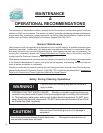
19
• It is important to operate and maintain the filter according to the manufacturer's specifications.
As a filter gets dirty, the water flow to the heat pump is reduced. The higher the pressure on the
filter gauge, the lower the flow rate.
• Similar to a dirty filter, large amounts of debris in the pump and skimmer baskets can reduce
water flow. Keep baskets free of debris.
• Check for improper valve settings. A partially closed valve after the filter, or a full-open bypass
around the heater, will cause insufficient water flow through heater.
• If the conditions listed above remain unresolved, the water flow through the heater may be
reduced to a point where internal safety devices (i.e.: “HP” or “HP5”) shut the heater off.
• Before calling for service, always check the filter, the pump basket, and water valve positions. If
the problem persists, please call AquaCal Customer Support at: (800)786-7751.
Maintain Proper Water Flow
Control Water Chemistry
CAUTION- Pool/Spa Refinishing Operations
During pool refinishing or acid cleaning, the water flow through the heater must be shut off. Water flow
to the heater must remain off until water chemistry is once again in balance and the water is clear in
appearance. Failure to follow these instructions may void heater warranty.
MAINTENANCE
& OPERATION (continued)
• IMPORTANT! Your heat pump is engineered for exceptional durability and reliability. And, this
unit’s heat exchanger—being equipped with titanium tubing—will be nearly impervious to water
chemistry damage. However, other components of the heater, and the remainder of the pool/spa
equipment in general, may be susceptible to damage from prolonged exposure to unbalanced
water chemistry. Likewise, bathers may be exposed to health risks if water chemistry is not
properly maintained.
• For the longevity of the entire pool/spa installation, and for the safety of bathers, it is strongly
recommended the water chemistry be checked regularly and maintained within proper norms.
Please see the table, below, for a complete listing of recommended water chemistry levels.
Chlorine . . . . . . . . . . . ........ . . .:
Bromine . . . . . . . . . . . . ........ . .:
pH . . . . . . . . . . . . . . . . . . ..........:
Total Alkalinity . . . . . . . . . ........:
Calcium Hardness . . . . . . . .....:
Total Dissolved Solids . . . . .....:
1.0 – 3.0 ppm in pools, 1.5 – 3.0 ppm in spas
2.0 – 4.0 ppm in pools, 3.0 – 5.0 ppm in spas
7.4 – 7.6 ppm in pools, 7.2 – 7.8 ppm in spas
80 – 140 ppm in pools, 80 – 120 ppm in spas
200 – 400 ppm in pools and spas
1,000 – 2,000 ppm in pools,
1,500 ppm above start-up TDS in spas
RECOMMENDED WATER CHEMISTRY STANDARDS*
* STANDARDS FOR COMMERCIAL APPLICATIONS MAY VARY LOCAL-TO-LOCAL...
ALWAYS MAINTAIN WITHIN LIMITS ESTABLISHED BY AUTHORITY HAVING JURISDICTION.


















